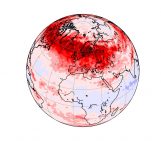
Earlier this summer journalists, broadcasters, writers and scientists gathered in Manchester, UK for the Third European Conference of Science Journalists (ECSJ) arranged by two prestigious organisations. Firstly, the Association of British Science Writers (ABSW) who provides support to those who write about science and technology in the UK through debates, events and awards. Secondly the European Union of Science Journalists’ Associations (EUSJA) who are responsible for representing 2,500 science journalists from 23 national associations in 20 European countries. EUSJA promotes scientific and technical communication between the international scientific community and journalists. This is mainly by organising events, workshops and by working with the European Commission in the interest of Science and Society.
The pre-conference networking event began a towering twenty-three floors above the ground at the highest Champagne bar in Manchester. Here the delegates were introduced to the notion of Manchester as a hub for science with a fly-by video of the ‘science quarter’. This stems from the library at the heart of the city and fans outwards to the south like a segment in an orange. This segment engulfs an impressive two universities, several hospitals and a science park.

Looking towards the south west of the city from “Cloud 23”, the bar on the 23rd floor of the Beetham Tower, Manchester, UK. Image credit: David Dixon
The following morning the conference began at the Manchester Conference Complex in the city-centre focussing on contemporary issues in science journalism and skills for professional development. The panellists and chairs were a mixture of academics and journalists, a range of nationalities and, with experience of the field of science communication. They were allowed to discuss a topic amongst themselves before the conversation was opened to all-comers.
The opening plenary began a discussion on how independent Europe’s science news is and how it can become hijacked by vested interests. For example, if a person writes a scientific story for a newspaper, are they biased by being paid by an external company to write that story? There was a consensus for openness in the funding process behind news stories so that the merits of the story lie in how impartial the writer is perceived to be as well as the content itself.
Although the second session of the day was focussed on the reporting of EU funded science (an 80 billion Euro question) it also gave delegates a chance to mention the elephant in the room – the Brexit. This is the will of a spectrum of people representing the whole political horseshoe for the UK to leave the EU. There was a feeling from the panel that the EU funding structure has allowed science to work on projects that are not just commercially viable in the short-term. The large benefit of cross-country collaboration in Europe was stressed repeatedly. This related to the general acknowledgement that in research the country of origin of specific researchers becomes irrelevant. These thoughts played into the much discussed post-Brexit question(s) – Will it be harder in time for the UK to access EU science funding given its determination to curb net migration and what exemptions (from the UK and EU) can be made for experts in their field? It was also discussed how the UK’s pot of EU science funding may be allowed to be divided up amongst other EU countries in the future. The discussion ended with a series of brief historical anecdotes of governments who favoured local policies/competition which have had a tendency to derail international collaboration. The main point being that research continued but the job was made harder.
The next two sessions focussed on starting a new publication and pitching your idea to an existing publication (sales idea). Using the case-studies of a range of recent start-up publications it was decided that what matters most for creating a publication is: focus, editorial quality, being online, design, collaboration and content.
The closing plenary was concerned with how to work for media that are sceptical about climate change – a place where a science communicator may be forced to go along with the editorial line against their own conviction. A conviction shared by the majority of scientists world-wide who say climate change is happening but argue over the rate that it is occurring. A good recommendation was not to preach but to state facts. The dangers of saying something sceptical as a way into the topic were debated. It was thought that this may backfire if the sceptical comment is later quoted as an expert opinion. At the end of the session the delegates pondered that if the building blocks of climate change were first conceived in 1896 how it is amazing to think that this topic is still controversial 120 years later!
For the final event of the day, the delegates made their way to the Bluedot festival at Jodrell Bank – a festival of music, science, arts, technology, culture, food and film in the shadow of the Lovell Telescope which was illuminated by Brian Eno using large scale projections to create a visual installation. Here the ABSW Science Writers’ Awards was hosted and this blog was short-listed for an award. It provided another great opportunity to network at this thought-provoking conference.





